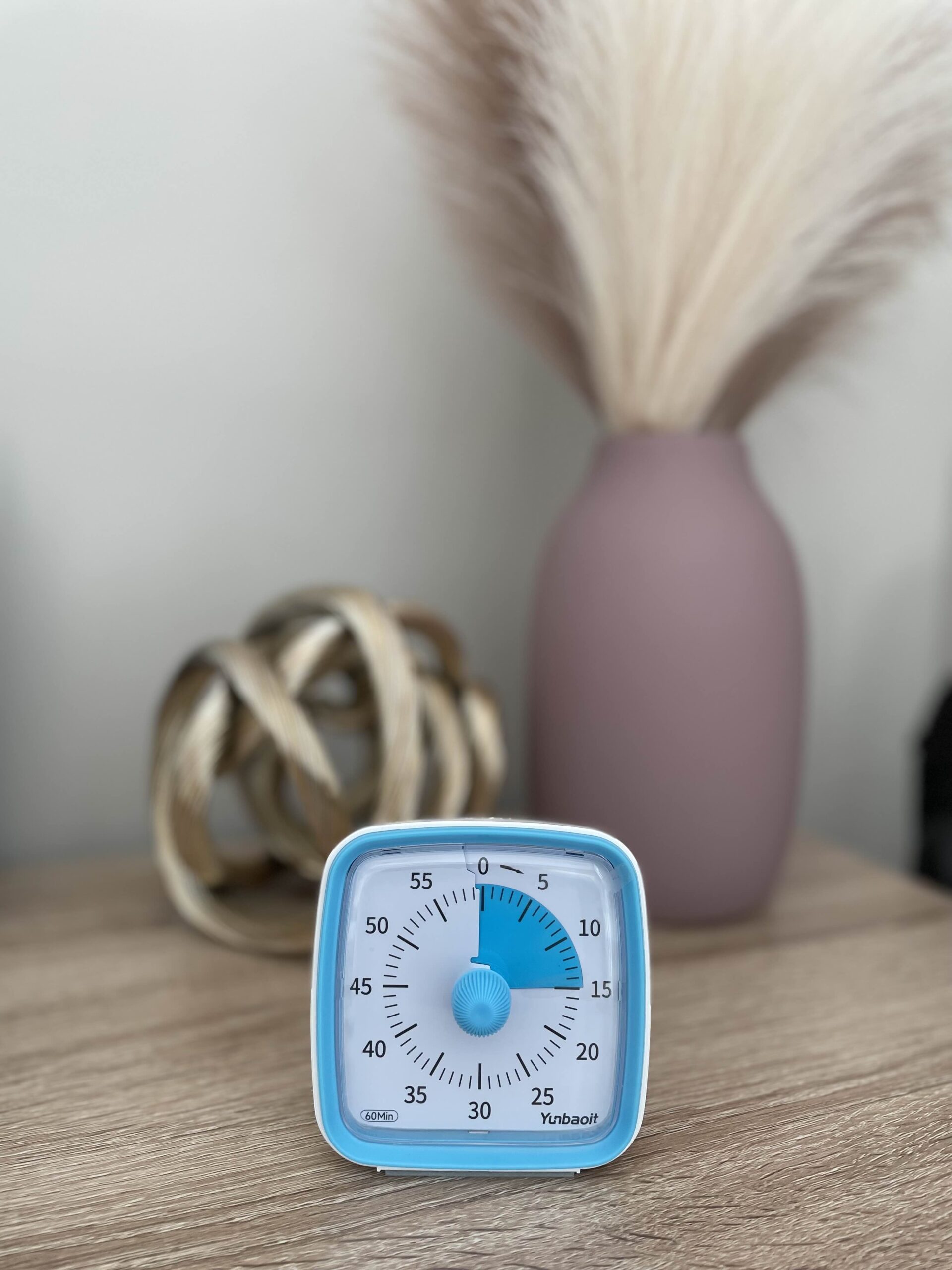As a stay-at-home mom, I often felt like I had a never-ending mental to-do list. It was overwhelming, and I wasn’t sure how to prioritize tasks or figure out when to tackle each one. That’s when I rediscovered a simple, yet powerful time management tool I used during my corporate days: time blocking! This powerful technique completely revolutionized my daily routine. Not only did it boost my productivity, but it also gave me back control of my time. In this blog, I’ll show you how time blocking for stay-at-home moms can transform your life too, helping you stay organized and stress-free.
What is Time Blocking?
Time blocking is a productivity method where you divide your day into specific blocks, with each block dedicated to a particular task or group of tasks. Unlike traditional to-do lists, time blocking ensures you’re intentionally allocating your time, making sure important activities get the focus they deserve. Personally, I also love using time blocking more sporadically! Since becoming a mom, I often lean into a looser, more flexible version of it. Got a free 10 minutes and want to knock out some chores? Time block it! It’s the easiest way to get a quick home reset when you’re home all day with little ones.
My Struggle Before Time Blocking
Before I started time blocking, my days often felt chaotic. I never felt truly productive or accomplished—either I couldn’t finish tasks, or I felt like I wasn’t getting much done at all. My mental to-do list was overwhelming, and whenever I tried to rest, guilt would creep in.
For some reason, it never occurred to me to apply the time management skills I used in my corporate job to managing my home. Instead, I thought I needed big chunks of time to get things done. This mindset made it seem like I didn’t have time to complete anything, so tasks would just keep piling up. Let’s be honest: when you’re at home with little ones, you rarely get large blocks of free time to do things like deep clean the bathroom—especially if you want to reserve nap time for a little self-care.
One important note: Just because you’re a stay-at-home parent doesn’t mean all the household responsibilities should automatically fall on you. There should still be an equitable division of tasks like cooking, cleaning, and parenting (outside your core “mom hours”). If you want to dive deeper into how I manage it all, check out my Agile Home Management System on Instagram!
Getting Started with Time Blocking
The best part? You only need a few basic tools to get started—and chances are, you already have them!
- A timer: One of the most important tools for time blocking is a reliable timer. I love using this simple visual timer that helps me stay on track and finish tasks on time.
- A task list: Write down the items you want to tackle, grouping similar tasks together for easy completion.
- A realistic time estimate: Be honest about how long each task will take. Personally, I prefer to keep time blocks short—no more than 30 minutes, with my average block being around 10-15 minutes.
How I Use Time Blocking Day to Day
Right now, I don’t block specific times of day because, well, I’m in the unpredictable toddler era! Some days there’s a nap, some days there’s not; some days we head out on an adventure, and other days, it’s all about managing moods (hello, toddler life!). Here’s how I structure a time block when I see an opportunity coming up.
1. Grouping Tasks with Task Batching
First, I review my tasks and group them based on proximity—like making the bed and cleaning the sinks in the primary bedroom, or tackling all the kitchen-related chores. This bundling technique is called Task Batching. (Want to learn more about task batching? Check out my Instagram post!
If you’re involving your kids in time blocking, try using this chore pad to help them stay on track with their tasks.
2. Estimating Time and Setting Boundaries
Once I’ve decided on the tasks, I make sure the time I estimate matches the time I actually have. Then I set my timer and GO! I don’t allow myself to stray from the list—even when my brain tries to convince me otherwise. If I need to move something to a different room, I’ll just place it in that room for now, unless it’s a quick 2-second task that I can handle on the spot. This helps me stay focused.
3. Stick to the Time Block, No Matter What
When the timer goes off, I stop—no matter if the tasks are done or not. This is a firm boundary I recommend everyone use. Without it, time blocking loses its effectiveness. Reflecting on what you completed (or didn’t) helps you plan for the next time block when these tasks pop back up on your to-do list.
4. What to Do with Leftover Time
Scenario: You finish all your tasks and notice you still have 4 minutes left. What now? You can take that extra time for yourself, or—what I recommend—tackle a small nearby task that you can start and finish in those 4 minutes. It’s totally fine to add to your list within that remaining time, but, as always, when the timer goes off, that’s it!
Time Blocking in Action
It’s pretty straightforward. I focus on one room at a time and break down each micro-task within that space. Take the kitchen, for example. Here are some micro-tasks that could fit into a kitchen time block:
- Unloading the dishwasher
- Loading the dishwasher
- Wiping down the counters
- Washing dishes in the sink
- Putting away hand-washed dishes
- Taking out the garbage
- Cleaning out the fridge
- Sweeping the floor
- Mopping the floor
The key is to keep your time blocks manageable. Don’t overcommit based on how much time you’ve got. If I only have 10 minutes, I might just focus on unloading and reloading the dishwasher, and that’s okay!
For keeping track of my time blocks and tasks, I use one of these magnetic whiteboards, which helps me visually stay on top of my household chores.
How Time Blocking Has Transformed My Day-to-Day Life
Here’s how time blocking has made a real difference in my daily routine:
- Increased productivity: I’m getting more done in less time by focusing on one task at a time and sticking to my time blocks.
- Better home task/SAHM balance: Time blocking has helped me find a healthier balance between managing household tasks and being present as a stay-at-home mom.
- Reduced stress and mental clarity: One of the biggest unexpected benefits of time blocking has been the mental clarity it provides. By assigning specific time blocks to each task, I no longer have to juggle a million thoughts in my head about what needs to get done. This has significantly reduced my decision fatigue—the constant mental strain of making decisions throughout the day. Instead of wasting energy figuring out what to do next, I can simply follow my plan, which makes my days flow more smoothly and stress-free.
- More quality time: With tasks under control, I’ve gained more time to spend however I please—whether that’s with my family, on self-care, or just enjoying some quiet moments.
Tips for Stay-at-Home-Moms
- Be realistic: Don’t overschedule yourself. Only commit to what you can realistically accomplish within your time blocks.
- Include self-care: Don’t forget to block time for yourself, whether it’s for a quick breather, a cup of coffee, or some well-deserved relaxation.
- Stay flexible: Life with kids is unpredictable, so be prepared to adjust as needed—sometimes plans will change, and that’s okay.
- Involve your kids: Help your kids understand your schedule. They can learn about time management too! If you’re curious about age-appropriate tasks, check out my blog post!
The most helpful tip? Stick to the time block! When that timer goes off, it’s time to stop—no exceptions. Think of it like those baking shows where the timer dings and contestants must step away from their creations, finished or not. That same approach applies here: it’s okay if you don’t finish everything.
Possible adjustments: You might need to adjust your tasks based on the time available or break them down into smaller steps to fit into shorter blocks.
Overcoming Common Challenges
Even with time blocking, obstacles are bound to pop up. Here are a few common challenges you might face—and how to handle them:
- Getting off track: Let’s be real, no one’s perfect. Distractions happen, even when we try our best to stay focused. If you get off track, don’t sweat it—just refocus and get back into your block when possible.
- Unexpected interruptions: Kids, pets, delivery drivers—life happens! You can’t predict every interruption, so try to be flexible. Build in buffer time if you can, and just roll with it when something unexpected pops up.
- Over-scheduling: It’s easy to overestimate what you can accomplish in a given block. But don’t worry—this is part of the learning process. With time, you’ll get better at gauging how long tasks actually take. Stay agile, adjust as needed, and try again next time!
Additional Benefits of Time Blocking
Beyond just boosting productivity, time blocking has also improved:
- My sleep habits: By having a structured day, I feel more at ease, and that’s definitely helped me sleep better at night.
- Personal goal achievement: I’m able to carve out time for my personal goals and make steady progress, even with a busy schedule.
- Overall mental health: With less stress and more control over my day, my mental health has significantly improved.
While my brain still races with to-dos, I’m no longer overwhelmed by them. They don’t steal away my ability to stay present. I know there will be time later in the day to tackle what needs to get done. Plus, I’ve got a prioritized list, and I can adjust it depending on how much time I’ve got.
It’s really about managing expectations and accepting that there are only so many minutes in a day. Especially when my “co-worker” (aka my unpredictable toddler) is a bit hard to predict—haha! The best part? I know my husband will pitch in and do his share, so if I don’t get to everything, it’s not a big deal.
However, time blocking works best when it’s paired with a clear backlog of tasks. That’s where my “Mastering Your Home Backlog” guide comes in. It’s the key to staying organized and making the most out of your time blocks. By having a structured list of tasks, you’ll know exactly what to prioritize when those free moments pop up, helping you reduce stress and stay on top of both daily chores and long-term projects.
Want to learn more about delegating home tasks and creating a household with shared responsibilities? Check out my Agile Home Management Guide which includes “Mastering Your Home Backlog” for more tips on staying organized and stress-free.
My Takeaways for You
I can’t recommend time blocking enough—it’s a strategy that works in any environment, whether you’re managing a household or working in an office. But I especially recommend it to my fellow stay-at-home mamas. Time blocking has been a complete game-changer for me as a stay-at-home mom. It’s helped me regain control over my days, reduce stress, and find more joy in both my daily responsibilities and my downtime.
That being said, it’s important to remember that time blocking is just one part of a larger approach to managing your home. To truly stay on top of everything, from daily chores to long-term projects, having a system to organize and prioritize tasks is crucial. That’s where my home management system comes into play, helping you not only block out your time but also build and manage a backlog of tasks that keeps you on track.
If you’re ready to take your time management to the next level, check out my guide, “Mastering Your Home Backlog”. This guide will walk you through how to create a prioritized list of tasks that works hand-in-hand with time blocking, giving you the clarity and structure you need to stay organized and reduce stress. With this system in place, you’ll know exactly what to work on when you have time available.
If you’re feeling overwhelmed, give time blocking—and building your home backlog—a try. You might be amazed at how these strategies can transform your life, too!
Have you tried time blocking? Or maybe you’re already building your own backlog of tasks? I’d love to hear about your experiences in the comments below!






